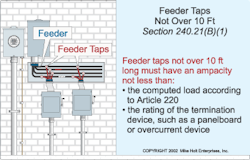Feeder rules are some of the most intimidating Code rules to apply. They are used in almost every commercial job and on all industrial facilities. They also apply to every transformer installation.
One such rule states that you must protect conductors against overcurrent in accordance with their ampacity (240.4). In addition, you must provide an overcurrent protection device (OCPD) in each ungrounded circuit conductor at the point where the conductors receive their supply (240.21). The NEC does permit tap conductors to have overcurrent protection set at a value that greatly exceeds the ampacity of the conductors, but this is only permitted under specific conditions outlined in 240.21.
Before we get into the details of 240.21, you must understand that a tap conductor isn't permitted to supply another tap conductor. In other words, you can't make a tap from a tap. Now let's look at the Code's specific requirements for feeder tap rules and secondary tap rules.
Feeder tap rules
There are five rules regarding feeder taps, but the most common include the 10-ft tap, the 25-ft tap, and the outside feeder tap.
10-ft feeder tap rule [240.21(B)(1)] — You don't have to install an OCPD at the tap point of a feeder tap if its length doesn't exceed 10 ft and if it meets the following requirements (Fig. 1 above):
-
The ampacity of the tap conductor is not less than the computed load in accordance with Art. 220, and not less than the rating of the device supplied by the tap conductors or the OCPD at the termination of the tap conductors.
-
The tap conductors aren't extended beyond the equipment they supply.
-
The tap conductors are installed in a raceway if they leave the enclosure.
-
The tap conductors have an ampacity of no less than 10% of the ampacity of the OCPD from which the conductors are tapped.
25-ft feeder tap rule [240.21(B)(2)] — You don't have to install an OCPD at the tap point of a feeder tap if its length doesn't exceed 25 ft and if it meets the following requirements:
-
The ampacity of the tap conductors is not less than ⅓ the ampacity of the OCPD protecting the feeder.
-
The tap conductors are terminated in a single circuit breaker or set of fuses having a rating no greater than the conductor ampacity as listed in Table 310.16.
-
The tap conductors are suitably protected from physical damage or enclosed in a raceway.
Outside feeder tap of unlimited length rule [240.21(B)(5)] — You don't have to install an OCPD at the tap point of a feeder tap of unlimited length as long as you meet the following requirements (Fig. 2 below):
-
The tap conductors are suitably protected from physical damage.
-
The tap conductors are terminated at a single circuit breaker or a single set of fuses that limit the load to the ampacity of the conductors. This single OCPD may supply any number of additional overcurrent devices on its load side.
-
The OCPD for the tap conductors is an integral part of a disconnecting means or located immediately adjacent to the device.
-
The disconnect is located at a readily accessible location outside the building or structure, or nearest the point of entry of the service conductors.
Are you still confused by the Code? For additional information on Code-related topics please visit www.mikeholt.com or send an e-mail directly to the author at [email protected].
About the Author

Mike Holt
Mike Holt is the owner of Mike Holt Enterprises (www.MikeHolt.com), one of the largest electrical publishers in the United States. He earned a master's degree in the Business Administration Program (MBA) from the University of Miami. He earned his reputation as a National Electrical Code (NEC) expert by working his way up through the electrical trade. Formally a construction editor for two different trade publications, Mike started his career as an apprentice electrician and eventually became a master electrician, an electrical inspector, a contractor, and an educator. Mike has taught more than 1,000 classes on 30 different electrical-related subjects — ranging from alarm installations to exam preparation and voltage drop calculations. He continues to produce seminars, videos, books, and online training for the trade as well as contribute monthly Code content to EC&M magazine.
